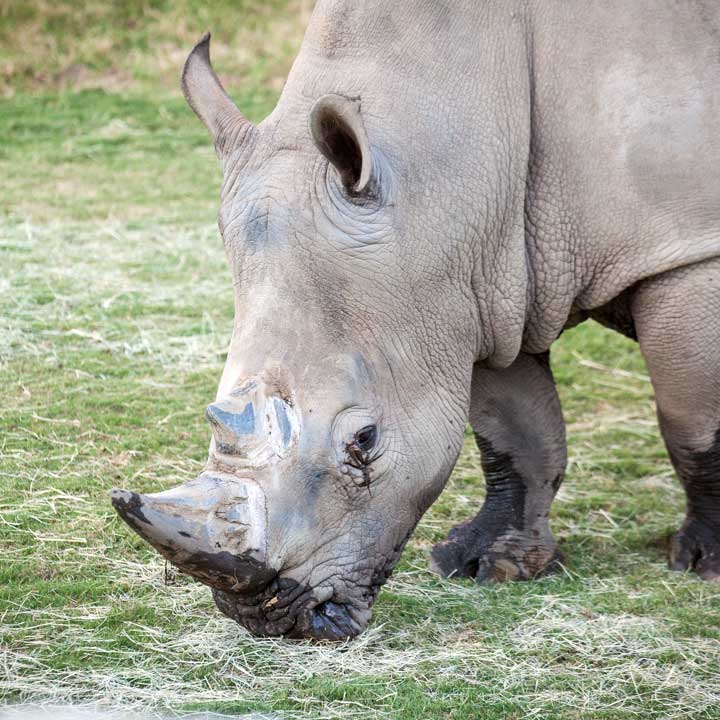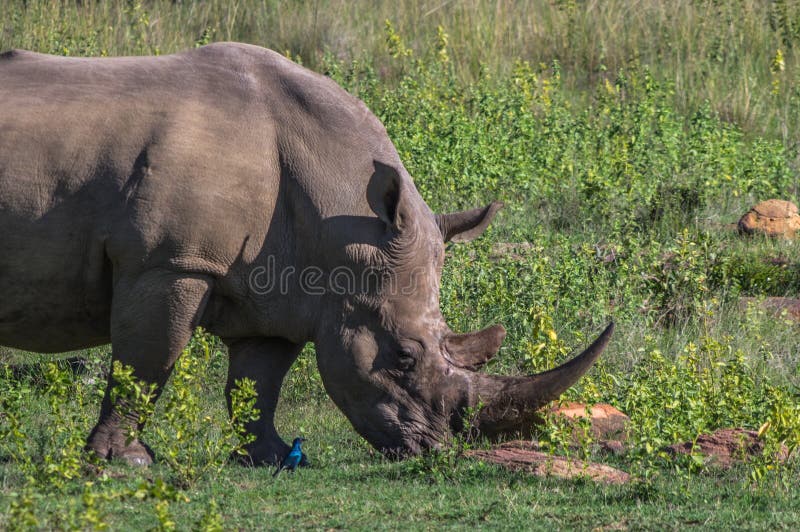
Calves normally move in front of their mothers, begin grazing after a few weeks and weaning occurs around 1 year of age. Following a 16-month gestation period, calves are born and able to stand within an hour, immediately trying to suckle. Male white rhinos may be 10 years old before they are ready to breed, whereas females mature around 6 or 7 years old and then may have a calf every 3 years.
#SOUTHERN WHITE RHINOCEROS PLUS#
White rhinos use a surprisingly wide range of vocal communication including contact calls, grunts and snorts, plus higher pitched squeals when distressed, and deep bellows signifying aggression or when threatened.


The odour reveals information about age, sex, the territorial status of males and whether females are receptive to breeding. This affords protection but while young rhino calves may be vulnerable to lions Panthera leo and spotted hyaenas Crocuta Crocuta, older animals are generally untroubled by predators.īoth male and female white rhinos advertise their presence using communal dung heaps known as middens. Females and their offspring may congregate in herds of up to a dozen or so animals. Accessed January 20, 2023.Dominant male white rhinos are solitary and territorial but may tolerate the presence of subordinate males. North Carolina Zoo mourns loss of Natalie, rhino with ‘big personality.’ News release. SMART is an app enabling national parks and other protected areas to be familiar with patterns of wildlife distribution and illegal activity and fight destructive activities like poaching.ĭonations for rhino conservation worldwide can be made online at NC Zoo Society Anti-Poaching Programs. Through SMART (Spatial Monitoring and Reporting Tool), the North Carolina Zoo strives to protect rhinos and additional species in the wild. The North Carolina Zoo staff works with rhinos at the zoo plus on conservation projects in various countries in Southern Africa to save this species. Currently populations in the wild of southern white rhinos are estimated to be between 19,000-21,000 and they still confront threats from poaching and habitat loss. Get most of their food in the wild while grazing the 40 acres of the Watani Grasslands.īy the start of the 20th century, southern white rhinos were hunted to near extinction for their horns, as they were mistakenly thought to offer medicinal benefits.Are herbivores who graze on grass, which helps maintain the diverse African grasslands, promote plant diversity, and offer grazing areas for other animals that share their natural habitat at the savannahs of Africa.
#SOUTHERN WHITE RHINOCEROS FULL#

“She was a very smart rhino, often leaving us wondering who was training whom. The North Carolina Zoo currently has a rhino crash of 7 females including Linda, Kit, Abby, Nandi, Bonnie, Jojo and Mguu.Īnimal management supervisor, Jade Tuttle, described Natalie, “She was an experienced mother and took on the ‘auntie’ role with our first set of calves in 2020 as they started to disperse from their mothers,” Tuttle said. 1 They are the most social rhino species and live together in groupings referred to as "crashes." Rhinos in the wild live into their early 30s and can live into their early 40s under human care. All 3 of her offspring are still alive at other accredited zoos in North America.Īfter elephants, southern white rhinos are the second-largest land mammal.

In 2007, Natalie arrived at the North Carolina Zoo with her son Lyonnel from White Oak Conservation Center in Florida, where she spent most of her life and birthed 2 males named Tony and Dominique. Georoff expressed that the full pathology report will offer more insight surrounding Natalie’s condition in the next weeks. “This week, the animal care and vet teams made the difficult decision to euthanize Natalie when treatment efforts were no longer effective." “Unfortunately, her health was in a steep decline despite treatment efforts, which led to a decrease in quality of life,” said Tim Georoff, VMD, AB, associate veterinarian for the North Carolina Zoo. Natalie was being treated for chronic kidney failure, anemia, and multisystemic disease over the last few months. According to an organizational release, 1 zookeepers remarked that Natalie had a “personality that matched her big 4,000+ pound size.” The North Carolina Zoo announced the death of Natalie, a 30-year-old southern white rhinoceros who was euthanized on January 10, 2023, following a period of declining health.


 0 kommentar(er)
0 kommentar(er)
